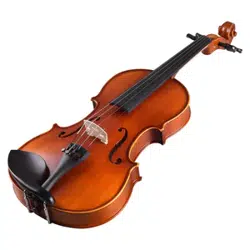Loading ...
Loading ...
Loading ...

www.PyleUSA.com
8
If you can’t get the string perfectly in tune, that’s okay. Just get it as close as you can. For the rest of the pegs, you’ll use
the same process, except when you go to tune the G and the D strings you’ll switch hands and use your left hand to
turn and your right hand to pluck and support.
Note: If you play a note that sounds too high, carefully bring your nger closer to the violin scroll until you hear the
right note. If you come across a note that sounds too low, slide it closer to the violin bridge until it is in tune.
Ways to Improve Your Intonation
Intonation is a lifelong challenge for string players – which is not surprising, since perfect intonation is mathemati-
cally impossible. You can go from one note to another via a dierent series of perfect intervals and end up with
slightly dierent frequencies.
1. Get comfortable: It is important for you to get physically comfortable with your instrument. You may have perfectly
good ears, but play out of tune because of a bad physical relationship with your instrument. Tension resulting from
poor practice can result in inaccurate shifts, and even in an inability to hear yourself objectively when playing.
2. Record yourself: This can be painful, but also enlightening. It helps to record yourself with decent equipment so that
you don’t sound bad merely because of the quality of the recording itself. For violin tone, stereo makes a big dierence.
3. Practise slowly: It takes time to hear pitch precisely, so practising fast too early while learning a piece will train
ngers to fall imprecisely, and will dull objective listening.
4. Delay vibrato: Never use vibrato until you have a clear idea of pitch. While learning a piece try playing it entirely
without vibrato, and then with a very small, centred vibrato, until the pitch relationships jell.
5. Practise scales and arpeggios accompanied by a drone: There is a simple note-generating programme on the
internet that you can use for this purpose.
6. Play solo Bach: In addition to all their other virtues, Bach’s sonatas and partitas for violin and his cello suites are
excellent intonation studies. Every issue of melodic versus harmonic intonation relative to the open strings arises,
forcing the player to decide consciously on a philosophy of intonation.
7. Play duets
8. Play chamber music
Loading ...
Loading ...
